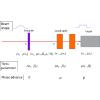当前位置:
X-MOL 学术
›
Phys. Rev. Accel. Beams
›
论文详情
Our official English website, www.x-mol.net, welcomes your
feedback! (Note: you will need to create a separate account there.)
Two-parameter model for optimizing target beam distribution with an octupole magnet
Physical Review Accelerators and Beams ( IF 1.5 ) Pub Date : 2020-06-23 , DOI: 10.1103/physrevaccelbeams.23.062802 Shin-ichiro Meigo , Motoki Ooi , Hiroshi Fujimori
Physical Review Accelerators and Beams ( IF 1.5 ) Pub Date : 2020-06-23 , DOI: 10.1103/physrevaccelbeams.23.062802 Shin-ichiro Meigo , Motoki Ooi , Hiroshi Fujimori

|
As hadron accelerators achieve increasing beam power, damage to targets is becoming increasingly severe. To mitigate this damage, nonlinear beam optics based on octupole magnets is attractive. Nonlinear optics can decrease the beam-focusing hazard due to failure of the rastering magnet. As a side effect of nonlinear optics, the beam size at the tail is known to expand drastically compared with linear optics, owing to defocusing in the nonlinear case; this may cause severe beam loss downstream of the octupole magnets. Beam shape and beam loss as a side effect of nonlinear optics have thus far been studied via a simplified filament model that ignores beam-divergence spread at the octupole magnet, so that the problem may be treated by a simplified transfer matrix. Several beam-tracking studies have been performed for the specified case given by the specified emittance and Twiss parameters, whereas a simplified model is required for application to the pragmatic beam tuning. In this study, a new generalized model is proposed for application to an octupole magnet, regardless of the filament-model approximation. It is found that the transverse distribution obtained by beam tracking can be specified by the introduction of only two parameters, namely the normalized octupole strength of and the of the phase advance from the octupole to the arbitrary position. With the new generalized model, the distribution with allowable beam loss is studied in detail. The best uniform shape is found for specific parameters of and that cannot be deduced from the filament model. However, to achieve the flat distribution, a considerable is required, incurring a large beam loss at the position having downstream of the octupole. To achieve the two antagonistic requirements of reduction of the beam-peak density and minimization of the beam loss, the transverse distribution is surveyed for a large range of beam position. It is found that a bell-shaped distribution with and can satisfy requirements. This result is applied to beam transport in the spallation neutron source at J-PARC. The beam profile calculated using nonlinear optics is compared with the experimental result. It is proven that the transverse beam distribution with nonlinear optics and an octupole magnet can be simplified by the present generalized model, which can be applied to other facilities using octupole magnets. The calculation result shows good agreement with the experimental data, and the peak current density is reduced by 50% compared with the linear-optics case with allowable beamwidth and beam loss.
中文翻译:

利用八极磁体优化目标光束分布的两参数模型
随着强子加速器获得越来越高的束功率,对目标的损害变得越来越严重。为了减轻这种损害,基于八极磁体的非线性光束光学系统很有吸引力。非线性光学器件可以减少由于光栅磁铁故障而引起的光束聚焦危险。作为非线性光学的副作用,由于非线性情况下的散焦,与线性光学相比,尾部的光束尺寸会急剧扩大。这可能会导致八极磁铁下游的严重束流损失。迄今为止,已经通过简化的灯丝模型研究了光束形状和光束损耗,这是非线性光学系统的副作用,该模型忽略了八极磁体上的光束发散扩散,因此可以通过简化的传输矩阵来解决该问题。对于由指定的发射率和Twiss参数给出的特定情况,已经进行了一些光束跟踪研究,而对于实用的光束调谐,则需要简化的模型。在这项研究中,提出了一种新的广义模型,可应用于八极磁体,而与灯丝模型的近似无关。发现通过光束跟踪获得的横向分布可以通过仅引入两个参数来指定,即归一化的八极强度 和 相位从八极移到任意位置。使用新的广义模型,详细研究了允许光束损失的分布。对于以下参数,找到最佳的均匀形状 和 无法从灯丝模型中推导出来。但是,要实现扁平化分配, 是必需的,在具有 在八极的下游。为了实现降低束峰密度和最小化束损耗的两个对立要求,对大范围的束位置进行了横向分布调查。发现带有 和 可以满足要求。此结果应用于在J-PARC的散裂中子源中的束传输。将使用非线性光学计算的光束轮廓与实验结果进行比较。已经证明,通过本广义模型可以简化具有非线性光学器件和八极磁体的横束分布,该模型可以应用于使用八极磁体的其他设备。计算结果与实验数据吻合良好,与线性光学在允许的束宽和束流损耗的情况下相比,峰值电流密度降低了50%。
更新日期:2020-06-23
中文翻译:

利用八极磁体优化目标光束分布的两参数模型
随着强子加速器获得越来越高的束功率,对目标的损害变得越来越严重。为了减轻这种损害,基于八极磁体的非线性光束光学系统很有吸引力。非线性光学器件可以减少由于光栅磁铁故障而引起的光束聚焦危险。作为非线性光学的副作用,由于非线性情况下的散焦,与线性光学相比,尾部的光束尺寸会急剧扩大。这可能会导致八极磁铁下游的严重束流损失。迄今为止,已经通过简化的灯丝模型研究了光束形状和光束损耗,这是非线性光学系统的副作用,该模型忽略了八极磁体上的光束发散扩散,因此可以通过简化的传输矩阵来解决该问题。对于由指定的发射率和Twiss参数给出的特定情况,已经进行了一些光束跟踪研究,而对于实用的光束调谐,则需要简化的模型。在这项研究中,提出了一种新的广义模型,可应用于八极磁体,而与灯丝模型的近似无关。发现通过光束跟踪获得的横向分布可以通过仅引入两个参数来指定,即归一化的八极强度 和 相位从八极移到任意位置。使用新的广义模型,详细研究了允许光束损失的分布。对于以下参数,找到最佳的均匀形状 和 无法从灯丝模型中推导出来。但是,要实现扁平化分配, 是必需的,在具有 在八极的下游。为了实现降低束峰密度和最小化束损耗的两个对立要求,对大范围的束位置进行了横向分布调查。发现带有 和 可以满足要求。此结果应用于在J-PARC的散裂中子源中的束传输。将使用非线性光学计算的光束轮廓与实验结果进行比较。已经证明,通过本广义模型可以简化具有非线性光学器件和八极磁体的横束分布,该模型可以应用于使用八极磁体的其他设备。计算结果与实验数据吻合良好,与线性光学在允许的束宽和束流损耗的情况下相比,峰值电流密度降低了50%。











































 京公网安备 11010802027423号
京公网安备 11010802027423号